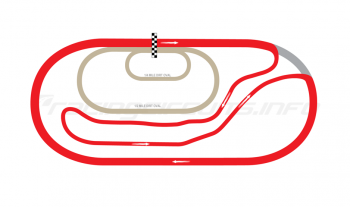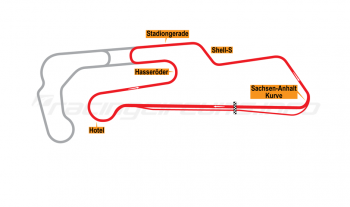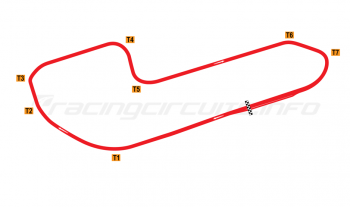Charade
Circuit Overview
The Circuit de Charade – better known by many as Clermont-Ferrand and sometimes as the also known as Circuit Louis Rosier – is something of an oddity in the current age; a modern re-imagination of a classic circuit which captures the essence of the original within considerably safer confines.
Built around the base of an extinct volcano, the original course was known for its challenging layout which favoured the most skilful drivers and riders. The modern circuit is still a formidable challenge, though is mainly experienced by those undertaking track days or competing in historic racing, though retains a round of the French Truck Racing Series.
Today the circuit is being revitalised as the 'Mountain e-Circuit', with a public-private partnership involving the local authority and Green Corp Konnection transforming the facilities to support electric mobility. The aim is to become the world's leading green energy producing circuit by surpassing the Indianapolis Motor Speedway with the installation of twelve hectares of solar panel fields.
Circuit History
The current circuit dates from 1989 but they had been dreaming of motor racing in the local area for almost as long as cars have existed; the first proposals for a race on the roads of the Auvergne region came in 1908, though these ultimately came to nought.
A second attempt was made after the Second World War, when President of the Sports Association of the Automobile Club of Auvergne, Jean Auchatraire, and accomplished racer Louis Rosier began planning a new course. A 4-6km course was proposed on streets to the edge of the city of Clermont-Ferrand and by 1955, all looked in place for the race. Then came the Le Mans disaster and suddenly the appetite for motor racing in the city streets waned and the race was cancelled.
Despite this setback, the desire for a race continued to burn strong and attention turned to the roads around the extinct volcano which dominated the city skyline. By adapting roads here, the first mountain course in France could be created and there was space enough for proper pit and paddock facilities to be constructed. The lure of what was sure to be the country's most demanding circuit proved too strong to resist for national and local authorities.
The mountain circuit emerges
Again with the help of Louis Rosier a course was drawn up and construction began in May 1957. Gradually the roads around the Puy de Gravenoire and Puy de Charade were adapted for racing and pit garages, a control tower and modest grandstand sprang up on the western end, close to the village of Saint-Genès-Champanelle. The circuit was ready for its first race in July 1958, when 60,000 excited spectators crowded along the route to watch a three hour endurance GT race, won by Innes Ireland in Lotus 1100, and a Formula Two race which fell to Maurice Trintignant in a Cooper.
At over five miles in length, this was a circuit of considerable challenge which brought out the best in the bravest of drivers. Denny Hulme commenting once that many drivers wore open-face helmets so they could throw up more easily as they went down the left-right-left hills that led off the volcanoes... It was fast too - Chris Amon's lap record of 1972 set the bar at an average of 104mph.
The circuit rose to international prominence first in the two wheel world, becoming host to the French Motorcycle Grand Prix in 1959, with John Surtees proving the 500cc victor for MV Augusta. The mountains of the Auvergne would go on to host the race a further nine times until 1974, notable winners including Phil Read, Mike Hailwood and Giacomo Agostini.
The four wheeled world was slower to catch on, with Formula One preferring the fast open roads of Reims and Rouen until 1965, when Clermont-Ferrand snatched away the French Grand Prix. Jim Clark won for Lotus with an all-British podium completed by Graham Hill and Jackie Stewart. The race was also notable for featuring the cameras of John Frankenheimer's Grand Prix movie, which stayed on after the race to complete filming, capturing the circuit for posterity as it enjoyed its heyday.
The Grand Prix returned three more times in 1969 (for which a new pit lane, separated from the track by Armco barrier, was created), 1970 and 1972, with victories falling to Jochen Rindt and Jackie Stewart (twice), though Chris Amon can count himself extremely unlucky not to win the 1972 event, having dominated the race for Matra before a puncture did for his chances. Punctures were a perennial hazard at Clermont-Ferrand, thanks to the dark volcanic rocks which lined the roadside. It was one of these stones, thrown up by the Lotus of Emerson Fittipaldi, which penetrated the visor of Helmut Marko that same year, blinding him in the left eye and ending his racing career.
In truth Clermont-Ferrand was never likely to survive as a venue for the French GP for long. The world's most complete and modern circuit sprang up at Paul Ricard in 1971 and the French GP moved away, never to return. Clermont-Ferrand soldiered on, continuing to host races for the Trophées d'Auverne over the next decade, though increasingly it became shunned by international racing as concerns about the public roads' dangerous nature rose. In 1980 three marshals were killed during a touring car race and the writing was on the wall; with no room to provide run-off areas on the mountain section, the classic course finally closed to racing in 1988.
The new circuit opens
Happily, this wasn't the end of the story as, recognising the importance of the track to the local economy, the General Council of Puy-de-Dôme financed the building of a shortened, modern circuit which utilised the lower sections only. Planning for a shortened circuit has actually began as far back as 1971 but several legal appeals and land issues delayed the work.
In the spring of 1988, construction finally got under way and the new Circuit de Charade was finally complete, opening with a grand ceremony in June 1989, attended by racing luminaries such as Fangio, Moss and Brabham.
The new course re-uses a large portion of the old one around the lower slopes, with the addition of nearly 1km of link road which departed just before Manson bend and rejoined near to the Champeaux curves. The remaining portions of the old circuit, including the fearsome Gravenoire section were no longer used, becoming instead normal public roads.
Pit and paddock facilities still remained relatively modest by modern standards and the new track was never likely to host international racing, however it quickly become a worthy addition to the national racing scene.
The Classic Racing School has also made its home at the Charade circuit, offering the chance to sample 1960s Formula Ford racers and learn about performance driving techniques with seasoned instructors.
In 2000, work began to finally close off the roads to the public, with the track becoming a truly permanent facility and boasting new pit garages and a widened pit lane. A new entry road was also constructed, greatly enhancing access to the circuit.
Towards a green future
In December 2020 the Departmental Council of Puy-de-Dôme unveiled a new plan to revitalise the circuit and safeguard its future as a centre for electric mobility. "Charade could be doomed to a slow death, but we will make it a springboard for the future with the mobility of tomorrow," announced Jean-Yves Gouttebel, president of the council.
To bring its plans to reality, the council has partnered with GCK (Green Corp Konnection), a mobility and green energy supply holding company headed by former freeride skier and current rally raid and rallycross driver Guerlain Chicherit. The group has extensive experience in lithium-ion battery production, as well as motorsport, running its own team in World Rallycross.
A new 12-hectare solar park will enable the circuit to switch entirely to green energy that it produces itself, thanks to GCK's expertise. Around the circuit a series of new buildings will also help to make the track more attractive to manufacturers and businesses, including electric car manufacturers and conversion specialists. An FIA homologated circuit reserved for electric karts will also be constructed, as will a new rallycross track for electric racers.
Perhaps somewhat controversially, the circuit plans to shift 90% of activity to zero-emission by 2025, meaning only 10 days will be reserved for competitions or activities involving internal combustion. It is expected this will allow the continuation of events like the Grand Prix Camions and the Trophée d'Auvergne.
"All manufacturers are switching to zero-emissions cars, so our activities will support this change for the next three years", explained circuit director Romain Sellier. "Our driving schools will gradually switch to zero emission, with the exception of the Classic Racing School which will keep its specificity. The number of track days, in their current form, will be reduced from 8 in 2021 to one or two from 2023." It is expected that new forms of electric competition will gradually replace those currently running with combustion engines.
While the future is very much geared towards electric mobility, for those wanting a glimpse of the past, the old route up in the hills still can still be driven as public roads, allowing everyone the chance to follow in the wheel-tracks of their racing heroes.
Jump onboard
Circuit info
- Circuit de Charade, Rond-point de Manson, 63122 St-Genès-Champanelle, France
- +33 4 73 295 295
- Email the circuit
- Official website
Rate This Circuit
Votes: 5435
Plan a visit
Get your race tickets!
Brought to you with: 
We've teamed up with Motorsports Tickets to bring you the best deals for Formula One, MotoGP, Le Mans and more.













